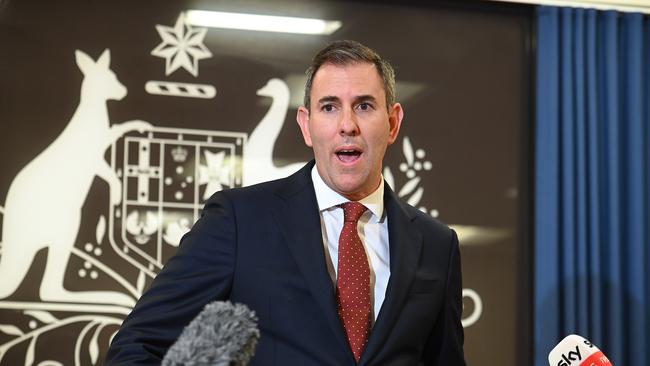Economic red flags turn the heat up on Reserve Bank
A series of flashing red economic indicators could force the RBA’s hand amid concerns national accounts will next week reveal a contracting economy.

You can now listen to The Australian's articles. Give us your feedback.
A rapidly slowing economy, soft labour market and other flashing red economic indicators could force the Reserve Bank to shift its central focus away from inflation amid concerns next week’s national accounts will reveal a contracting economy in the June quarter.
While Australian Bureau of Statistics data shows inflation remains sticky but is tracking down, other economic measures, including construction, investment, consumption and wages growth, are falling backwards or flatlining.
With US, New Zealand and Canadian central banks lowering interest rates from a higher bar in response to deteriorating labour markets and sluggish growth, the RBA board will come under pressure in its final three meetings of the year to assess weak economic indicators outside inflation.
The central bank, which will meet for the first time in 2025 on February 17, is expected to map out a strategy that is likely to work towards cutting the 4.35 per cent cash rate in the first half of next year, contingent on continued falls in inflation.
With job advertisements on Seek down by 15 per cent and job applications up by 60 per cent, The Australian can reveal JobSeeker and Youth Allowance (Other) levels have continued to swell in recent months, taking the number of recipients to 910,000.
Since hitting post-pandemic lows in September last year, jobless welfare numbers have grown by 83,490 in 10 months, a monthly average of 8439. The number of recipients on JobSeeker for less than a year has grown by 82,525 over that period, with an additional 17,350 younger Australians shifting on to payments.
Weaknesses in the labour market are expected to worsen in coming months and push up the 4.2 per cent unemployment rate recorded in July, which is expected to push more Australians on to JobSeeker.
While the central bank came close to hiking the cash rate to 4.6 per cent at its most recent meeting, RBA governor Michele Bullock has made it clear that underlying inflation is proving persistent.
Following the August meeting, Ms Bullock said a reduction in the cash rate over the next six months “doesn’t align with the board’s current thinking”.
As the Albanese government focuses on immediate cost-of-living support and driving medium to long-term economic growth, Treasurer Jim Chalmers said “higher interest rates are hammering consumption and slowing our economy”.
“Nearly a million jobs have been created since the government was elected but we’ve been upfront that we expect the labour market to soften,” Dr Chalmers told The Australian.
“We’ve already seen signs of this with a rise in the unemployment rate, falling jobs ads and lower average hours worked in recent months.
After weaker than expected residential construction activity was revealed this week, new ABS figures, released on Thursday, showed business investment falling 3.6 per cent in the June quarter.
Total new capital expenditure fell 2.2 per cent, buildings and structures dropped by 3.8 per cent and equipment, plant and machinery lowered by 0.5 per cent. Capital expenditure in non-mining industries fell by 7.7 per cent.
Victoria recorded the largest fall across states and territories, with capital expenditure down 4.2 per cent compared to the same period last year and 4.1 per cent versus the March quarter. Fuelled by higher mining investment, capital expenditure grew by 23.5 per cent in the Northern Territory.
Oxford Economics’ Sean Langcake said the “relatively weak” figures indicated the economy may have contracted in the three months to June.
“Coupled with weakness in retail spending … there is a material chance GDP growth was negative in the quarter,” Mr Langcake said.
Employment Minister Murray Watt said the labour market had “shown remarkable strength and resilience, despite the significant headwinds that continue to buffet the Australian economy”.
“To date, we’ve created 989,200 jobs since the Albanese Labor government came to office, which is more jobs in a single parliamentary term than any government in history,” Senator Watt said.
AMP chief economist Shane Oliver said that, although inflation was holding the RBA back from rate cuts, other factors, including the labour market and weak economic activity, could shift the central bank’s focus.
Mr Oliver, who believes the RBA won’t cut rates until February at the earliest, despite evidence of a slowdown, said “we are getting ongoing soft data on the economy, which in time will mean less pricing power”.
“If we got a run of weak jobs data then the RBA could pivot from worrying about inflation so much to worrying more about jobs, like the (US) Fed has or like the RBNZ has,” Mr Oliver said.
“They could pivot but at this stage we’re still waiting for that run of weak jobs data and literally if we had a financial crisis they would pivot towards cuts.
“We’ve seen eight quarters in a row of falling job vacancies (in the labour market), wages growth looks to have peaked, rise in award wages this year is 3.75 per cent, last year it was 5.75 per cent.”
Additional reporting: Jack Quail




To join the conversation, please log in. Don't have an account? Register
Join the conversation, you are commenting as Logout